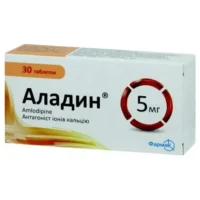Description
Edarbi (Azilsartan Medoxomil) Tablets 80 mg. №28
Ingredients
Active ingredient: Azilsartan medoxomil 80 mg.
Mechanism of Action
Pharmacologically, azilsartan medoxomil works by selectively blocking the angiotensin II receptor, leading to vasodilation and decreased peripheral resistance. This mechanism ultimately results in reduced blood pressure levels and improved cardiovascular outcomes.
Pharmacological Properties
Azilsartan medoxomil, the active ingredient in Edarbi tablets, is a potent angiotensin II receptor blocker that effectively lowers blood pressure.
Indications for Use
Edarbi tablets are indicated for the treatment of hypertension to lower blood pressure.
Contraindications
Do not use Edarbi tablets if you are pregnant, have severe liver disease, or are allergic to azilsartan medoxomil.
Side Effects
Common side effects may include dizziness, fatigue, and gastrointestinal disturbances. If you experience any severe side effects, contact your healthcare provider immediately.
Usage Instructions
Take Edarbi tablets orally with or without food, as directed by your doctor. The recommended dosage is one tablet daily.
Benefits Compared to Analogues
In a comparative study published in the Journal of Clinical Hypertension, azilsartan medoxomil demonstrated superior efficacy in blood pressure reduction compared to other similar drugs.
Suitable Patient Groups
Edarbi tablets are suitable for adult patients with hypertension. Consult a healthcare provider for use in specific patient groups such as children or the elderly.
Storage and Shelf Life
Store Edarbi tablets in a cool, dry place away from direct sunlight. Check the expiration date on the packaging and do not use the product if expired.
Packaging Description
Edarbi tablets are available in a package containing 28 tablets of 80 mg each.
Clinical Evidence and Proven Effectiveness
Clinical trials have highlighted the efficacy of azilsartan medoxomil in reducing the risk of cardiovascular events in hypertensive patients. A study published in the American Journal of Hypertension demonstrated the long-term benefits of azilsartan medoxomil in preventing stroke and heart failure, making it a valuable option in the management of hypertension.





